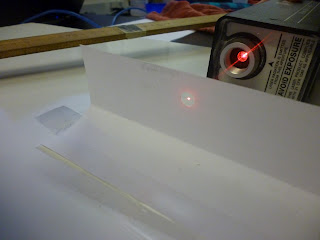The purpose of this experiment
is to measure a human hair using the concepts of light interference. This
experiment was conducted using a human hair, a 3x5 notecard, a whiteboard, and
a microscope. A human hair was taped across a hole in 3x5 notecard, and let it
parallel to the whiteboard at a known distance. A laser was used to point
toward the white board through the hair. The distance between the first 2 fringes
was recorded. The diameter of the human hair was measured experimentally using
a micrometer, and this result was compared with the actual diameter of the
hair. The theoretical result was computed using
d=λL/y
where d= diameter
of the hair
λ= wavelength of the laser
L= Distance
between the laser and the whiteboard
y= distance
between 2 adjacent diffraction pattern.
Figure 1: A laser beam perpendicular to the axis passing through the hair
Figure 2: Diffraction pattern formed by the laser beam due to light interference
Figure 3: Measuring the diameter of the hair using a micrometer
Data and
Analysis
Table 1
Wavelength,λ
(nm)
|
632.8
|
Distance,L (cm)
|
109 ± 1
|
Distance between 2 fringes,y (cm)
|
0.8 ± 0.05
|
Experimental diameter of the hair (μm)
|
90.0 ± 3
|
Actual Diameter of the hair (μm)
|
86.2 ± 1.25
|
% error (%)
|
4.41
|
Conclusion
As shown in table 1, the experimental diameter of the hair was measured
to be 90 μm while
the actual diameter was 86.2 μm.
Therefore, the percent error was very small, and these values were within the
uncertainties of each other since the smallest experimental diameter was 87 μm and the largest actual diameter
was 87.45 μm.
Based on the observation of this experiment, light interfered constructively
and destructively depending on the distance travelled by each of the secondary
light source. At the middle of the light source where both secondary light sources
travelled equal distance, the light was the brightest. However there was no
light when their distance travelled was a half wavelength difference. Therefore,
there was a dark space between 2 bright fringes as shown in figure 2. Since
the distance between the lens and the white board was a lot larger than the
diameter of the hair, the equation mentioned could be used to compute the diameter
of the hair. Otherwise, this equation could not be applied in this case. In
addition, the laser beam had to be perpendicular and pass through the hole equally
to form the accurate diffraction patter. Despite these disadvantages, the light
interference method could accurately measure the diameter of the hair or the width
the slits, but the micrometer had more uncertainties in measurement. Yet using
the micrometer could be done faster to obtain an approximately accurate result, and there was no need to consider about the distance between the micrometer and the hair.



No comments:
Post a Comment